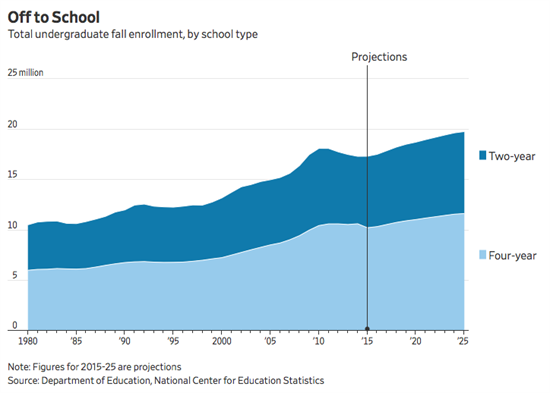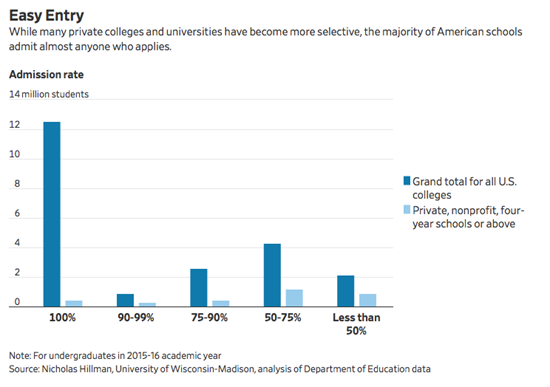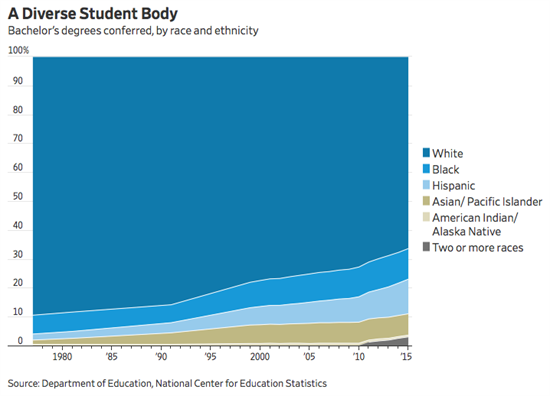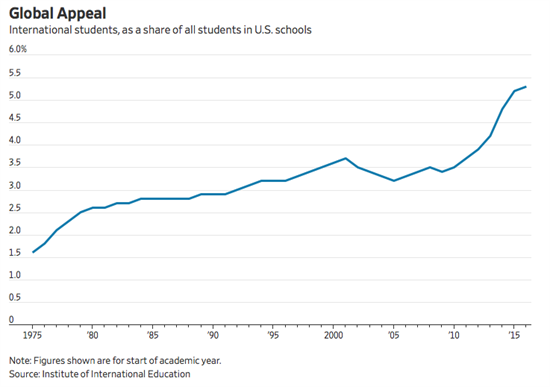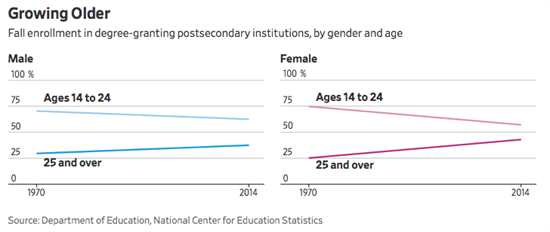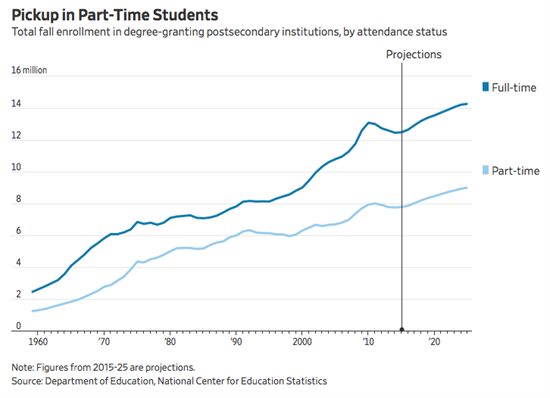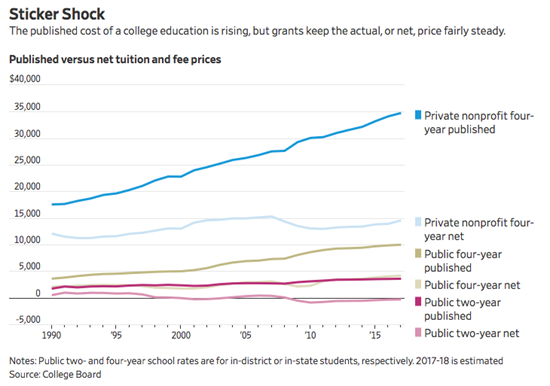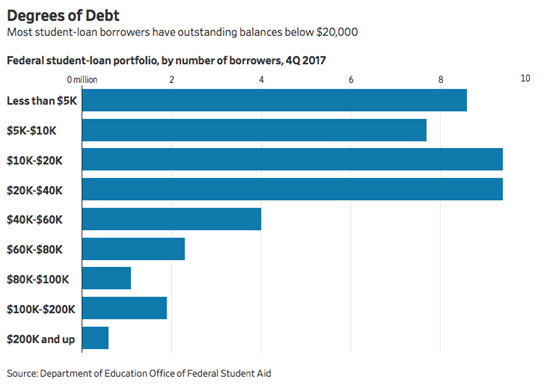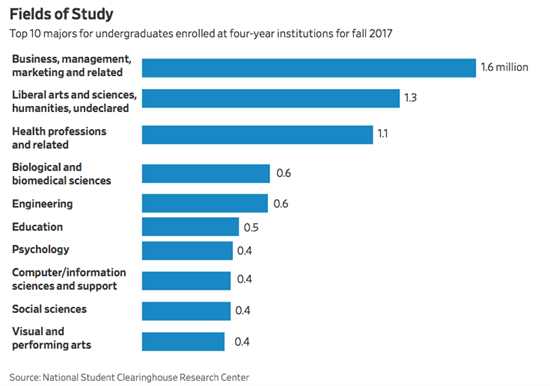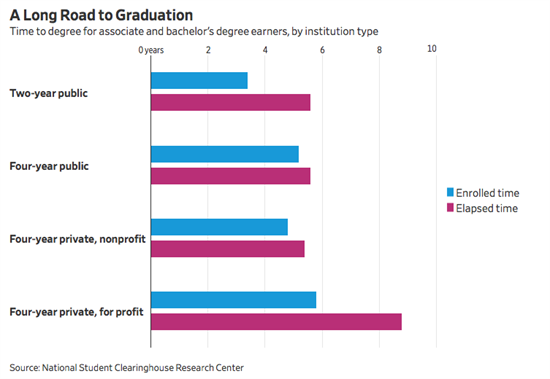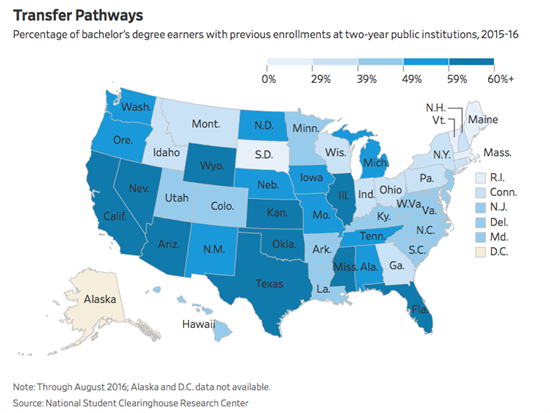 |
Today's College Students Aren't Who You Think
By Melissa Korn and Kathryn Tam
Education Secretary Betsy DeVos and Republicans on Capitol Hill are advocating a fundamental rethink of higher education, pushing for more vocational programs and shorter pathways to credentials.
With a House bill aimed at rewriting the 52-year-old Higher Education Act introduced late last year and a Senate version expected in the spring, lawmakers have helped fuel a national discussion over who should be on the path to a college degree—and who’s there now.
Today’s college students aren’t just 18-year-olds living in cramped dorm rooms on ivy-covered campuses.
Rather, the men and women who attend college often work at least part-time to cover their tuition and living costs, enroll in schools they were guaranteed to get into and major in professionally focused degrees like business and nursing.
While loans are often still necessarily for many students, the debt burden for undergraduate studies generally isn’t crippling thanks, in part, to institutional grants. Even with loans, the payoff is still solid as the wage gap between college haves and have-nots continues to grow.
Here’s a look at who today’s college students are and where they come from, in charts:
TYPE OF SCHOOL
The Wall Street Journal and Times Higher Education ranked the top 1,056 U.S. colleges and universities, but those schools enroll less than half of American students. More than 4,000 colleges are eligible to receive Title IV federal student aid, including public and nonprofit, private universities, community colleges and for-profit institutions.
Forty percent of the roughly 17.5 million undergraduate students are enrolled in two-year institutions.
SELECTIVITY
While many Ivy League institutions accepted fewer than one in 10 applicants for the current freshmen undergraduate class, they are far from the norm. The vast majority of college students attend institutions that admit nearly anyone who applies.
DIVERSITY
As the nation’s population grows more racially and ethnically diverse, so too has the profile of American colleges’ student bodies. A larger share of students than ever before are nonwhite, with the most dramatic gains over the past 20 years coming among Hispanic students.
The international student population has also soared as schools look abroad for full-paying students to bolster their finances. However, the rate of growth slowed last year amid increased competition from schools in other countries and concern about immigration policies in the U.S.
SCHOOL WORK
Plenty of freshly minted high-school graduates go off to college straight away. But many students are old enough to be those teens’ parents, seeking to retool their skill set or start new careers while holding down jobs and taking care of families. More students are over 24, and nearly one-third of all college students now attend part-time.
Even those not returning to school midcareer are more likely to be working, picking up jobs at local shops and restaurants and anywhere else they can earn a paycheck to offset living expenses and tuition bills. Ten-percent of students enrolled full-time work at least 35 hours a week, while nearly half of part-time students hold full-time jobs.
COSTS
College is expensive, and getting more so. But
few students pay full freight, receiving hefty need-based or merit-based grants from their institutions. Nearly 85% of students at private, nonprofit undergraduate programs--often liberal arts colleges--can expect to receive aid from their schools.
Those who are on the hook for a significant share of their education expenses take out loans, though such debt burdens vary widely by school and state and are concentrated at relatively low levels.
MAJORS
Liberal arts and humanities fields like English and sociology programs, much maligned by politicians who say they lead to dead-end jobs and low pay, remain popular for many of today’s college students. But even more students pursue professionally focused degrees in business. Health-related programs round out the top three.
Those fields of study are paying off. In 2016, college graduates earned 56.6% more than their counterparts with just high-school diplomas, even when controlling for gender, race and experience. That is the highest wage gap recorded since at least 1973, according to an analysis by the nonprofit Economic Policy Institute.
TIME TO DEGREE
Four-year colleges often take longer than four years, with many students changing majors or programs and requiring extra time to complete their degrees.
Some students take a break from their studies partway through their education, adding to the overall time it takes to get to the finish line. The federal government tracks bachelor’s degree graduation rates for full-time students by looking at whether they made it through in six years, not just in four.
One major reason that students take more than four years to graduate is that many change schools, and the credits they earned don’t all transfer over with them. In some parts of the country, more than half of college graduates started at a community college.
To read online, click here.
To learn more about the PROSPER Act, click here.


